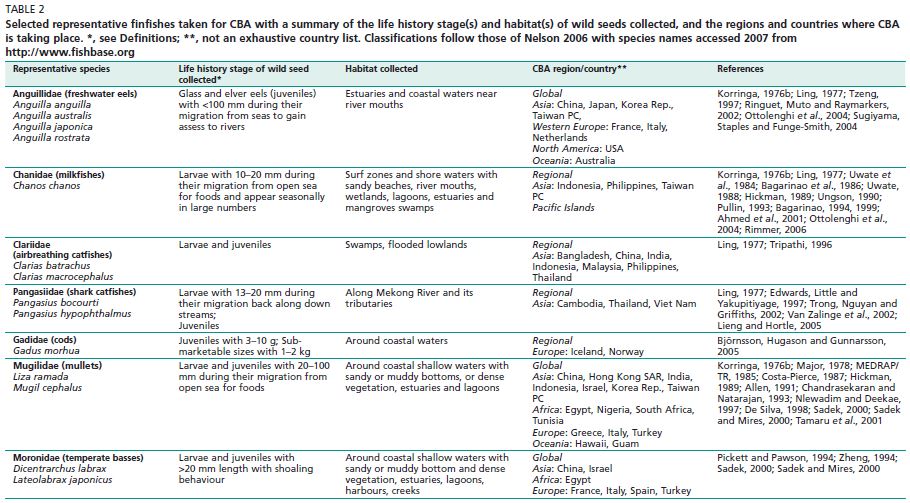REPRESENTATIVE SPECIES IN CBA
Selected representative species for CBA from four taxonomic groups, molluscs, crustaceans, echinoderms and finfishes, are summarized, with a focus on understanding their life history stage(s) and habitat(s) captured and collected as seeds, the regions and countries where CBA is taking place (Tables 1 and 2). Four classes of species in CBA were identified according to market demand both locally and internationally, stock condition, high predictability in time and/or location, ease of capture and accessibility. Most are higher value species rather than regular food for cheap daily consumption because these are the species on which much of CBA is focused, so economic forces are also a major factor in determining which species are selected for CBA.
• Certain valuable species are taken at a wide range of life history stages, from larvae and juveniles of various sizes to adults. Highly valued species included are spiny lobsters (Jasus and Panulirus spp.), mud crabs, sea cucumbers (Holothuria and Parastichopus spp.), Atlantic cod (Gadus morhua), groupers (Epinephelus spp.), the humphead wrasse (Cheilinus undulatus) and tunas (Thunnus spp.). As adult stocks have become overexploited, attention has turned increasingly to gaining possession of these species at an earlier life history stage and raising them to marketable sizes.
• Among certain finfishes, such as eels (Anguilla spp.), milkfish (Chanos chanos), shark catfishes (Pangasius spp.), mullets (Liza and Mugil spp.), temperate basses (Dicentrarchus and Lateolabrax spp.), jacks (Seriola spp.), rabbitfishes (Siganus spp.) and tunas, their early life history stages (and to some extent the adult stage) collected for CBA are highly predictable in time and/or location. These species have aggregation, migration and/or shoaling behaviours, the routes, habitats and seasons of which are well-known. Aggregation or shoaling makes such species particularly vulnerable to over-fishing because large numbers can be caught very efficiently and often easily, becoming the basis of seasonal fisheries.
• The habitats of early life history stages of certain desirable species may be very well-known or distinctive and easy to access. For example, for most molluscs spats settle in intertidal or subtidal zones of coastal waters and are easily and readily collected on artificial settlement collectors or identifiable natural substrates. For crustaceans, such as spiny lobsters and mud crabs, pueruli and megalopa (i.e. larval stage) pre-settlement occurs in large numbers near estuaries, lagoons or mangrove areas. For freshwater catfishes (Clarias spp.) and snakeheads (Channa spp.), the early life history stages are readily found in swamps, shallow waters and marshes.




• In many places, although CBA was originally a localized practice, the growing demand for seafood, declining wild stocks of some species, and improved means of international transport of live aquatic organisms, now mean that regional and global trade in wild-caught seeds is common, especially for finfishes. For example, Asian countries such as China and Japan import European glass and elver eels (Anguilla anguilla) to make up the short supply of the local species, Japanese eel (Anguilla japonica) in CBA (Ottolenghi et al., 2004; J.B. Liu personal communication, 2007). For the shark catfish (Pangasius hypophthalmus), regional transfer (mainly from Cambodia to Viet Nam) is still common since the ban on wild seed collection in Viet Nam (Trong, Nguyan and Griffiths, 2002; Van Zalinge et al., 2002). Regional transfer within Southeast Asian countries of groupers (e.g. Epinephelus spp.) is common; for example, China transferred wild seeds of the Hong Kong grouper (Epinephelus akaara) to China Hong Kong Special Administrative Region (SAR) for CBA in the 1980s after overexploitation of adult and seed resources locally (Tseng and Ho, 1988; Wilson, 1997; Sadovy, 2000). For the Japanese amberjack (Seriola dumerili), China and Viet Nam have exported wild seeds to Japan since the 1980s (Dao, 1999; Ottolenghi et al., 2004). For the red seabream (Pagrus major), China Hong Kong SAR was once the major supplier of its wild seeds to Japan in the 1980s–1990s before the seed fishery dwindled (Wilson, 1997).